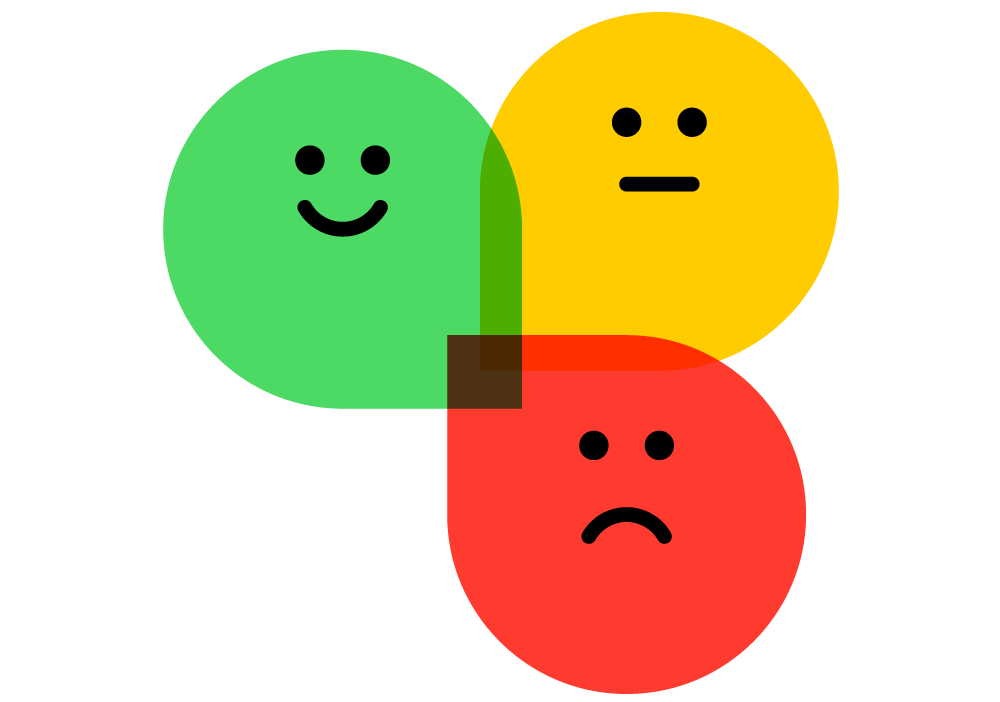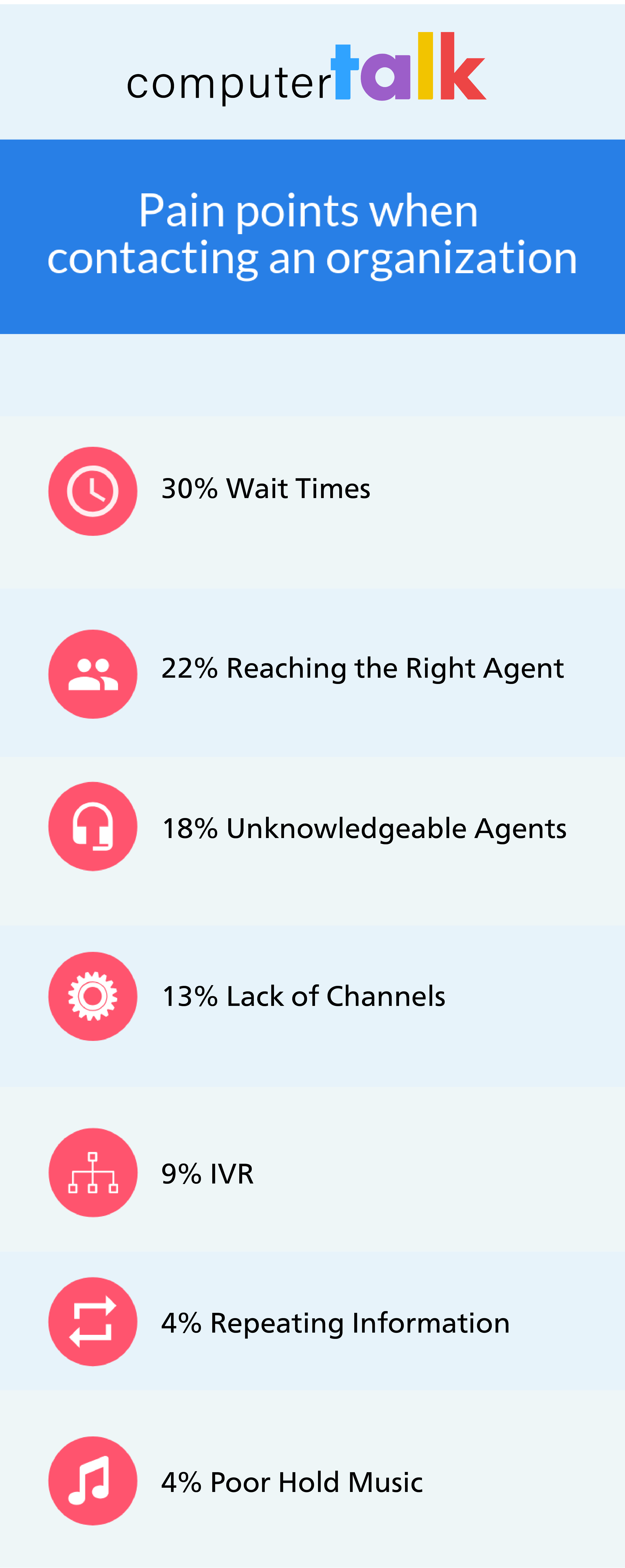Featured
How to Overcome the Top 6 Customer Frustrations When Contacting an Organization
Published On September 4, 2019 | Last Updated March 3, 2025

At ComputerTalk, we’re not just contact center providers; we’re customers too. We know firsthand the frustrations that come with reaching out to a business’ customer service team.
Whether it’s long wait times, navigating complicated IVR menus, or repeating information multiple times, these pain points create negative customer experiences and can drive customers away.
We surveyed our staff and asked, "What is your biggest pain point when contacting an organization?" Their responses highlighted some of the most common customer service frustrations, many of which can be solved with simple contact center features without requiring major overhauls.
By addressing these key challenges, your organization can improve customer satisfaction, enhance loyalty, and increase operational efficiency. Here are the top six customer frustrations and the best ways to overcome them.
1. Long Wait Times
Why Do Customers Hate Long Wait Times?
The biggest frustration our staff shared was waiting on hold for extended periods of time before speaking to an agent. Customers value their time and expect quick service. Long wait times can lead to abandoned calls, customer dissatisfaction, and even lost business.
Common Causes of Long Wait Times
- Understaffing: Not enough agents available to handle call volume.
- Inefficient workflows: Agents spending too much time on each call due to outdated processes or lack of necessary information.
- Unexpected call surges: A sudden influx of calls due to unforeseen circumstances.
How to Reduce Contact Center Wait Times
- Use Workforce Management (WFM) tools: Accurately forecast call volumes and schedule agents accordingly.
- Implement CRM integrations: Provide agents with instant access to customer information, reducing call handling time.
- Offer a callback option: Let customers request a callback instead of waiting on hold.
- Use intelligent call routing: Direct customers to the right agent quickly based on their needs.
- Implement self-service options: AI-powered chatbots and IVRs can handle simple queries without agent intervention.
2. Difficulty Reaching the Right Person or a Live Agent
Why Is Reaching an Agent So Frustrating?
Many customers get frustrated navigating complex IVR systems that force them to listen to long menus or go through multiple layers before reaching a live agent.
Common Causes of Difficulty Reaching an Agent
- Overcomplicated IVR systems: Too many menu options or unclear prompts.
- Lack of direct agent access: No option for customers to bypass IVR when needed.
- Poor routing strategies: Calls not being directed to the right department.
How to Improve IVR Design
- Optimize menu options: Keep IVR prompts clear, concise, and relevant to customer needs.
- Use AI-powered speech recognition: Let customers state their issue verbally rather than pressing buttons.
- Enable direct agent access when needed: Offer an option to connect with a representative immediately.
- Monitor IVR performance: Analyze call data to identify and resolve IVR bottlenecks.
3. Unhelpful or Uninformed Agents
Why Do Agents Appear Uninformed?
Customers expect agents to provide accurate and timely responses. However, agents may lack the necessary information due to inadequate training, inefficient processes, or limited access to customer history.
Common Causes of Uninformed Agents
- Insufficient training: Agents not being properly educated on products, services, or processes.
- Lack of knowledge base integration: No easy access to information during customer interactions.
- Disjointed customer data: Customer history spread across multiple systems without proper integration.
How to Improve Agents’ Knowledge
- Implement skills-based routing: Direct calls to agents with the right expertise.
- Provide ongoing training: Regular training sessions help keep agents informed and confident.
- Integrate CRM and knowledge bases: Equip agents with real-time customer data and problem-resolution tools.
- Use performance analytics: Track agent efficiency and customer satisfaction to identify areas for improvement.
4. Limited Communication Channels
Why Is Omnichannel Support Essential?
Not all customers want to call a contact center. Many prefer digital channels like live chat, email, or social media to resolve their issues.
Common Causes of Limited Communication Channels
- Legacy systems: Older technology that does not support multiple channels.
- Lack of omnichannel strategy: No integration between different communication methods.
- Resource constraints: Not enough staff to support multiple customer engagement platforms.
How to Offer Multiple Communication Channels
- Implement an omnichannel contact center: Enable customers to contact you via phone, chat, email, SMS, and social media.
- Offer self-service options: AI-driven chatbots and FAQ pages can handle simple queries without live agent intervention.
- Ensure seamless transitions between channels: Allow customers to switch from chat to voice without losing context.
5. Repeating Information
Why Do Customers Hate Repeating Themselves?
Customers get frustrated when they provide details in an IVR or chatbot only to repeat the same information to a live agent. This redundancy wastes time and creates a poor customer experience.
Common Causes of Repetition
- Lack of system integration: Customer data not being transferred between platforms.
- Poor internal communication: Agents not having access to previous customer interactions.
- Chatbot or IVR limitations: Systems that do not retain input when transferring customers.
How to Eliminate the Need for Repetition
- Integrate IVR with CRM: Pass customer input directly to agents so they have context before the conversation starts.
- Enable seamless chatbot-to-agent transfers: Ensure chat history is visible to agents when a customer is transferred.
- Use automated case management: Store interaction history so customers never have to repeat themselves, even across multiple interactions.
6. Poor On-Hold Music
Why Does Hold Music Matter?
Studies show that music affects mood, and customers often reach out to support teams while already feeling frustrated. The wrong on-hold music can make the wait even more unbearable.
Common Causes of Poor On-Hold Music
- Repetitive or low-quality audio: Annoying, distorted, or monotonous soundtracks.
- Lack of personalization: Customers forced to listen to a single type of music.
- No informative alternatives: Missed opportunities to provide useful updates while customers wait.
How to Improve the On-Hold Experience
- Let customers choose their hold music: Some companies allow customers to select from different music genres.
- Use brand-aligned music: Match hold music to your brand’s tone and customer expectations.
- Provide estimated wait times: Keep customers informed about how long they will need to wait.
- Offer informative messages: Use hold time to share helpful tips or promotional offers.
Overcoming Customer Frustrations
Providing an excellent customer experience is critical to retaining and satisfying customers. By addressing these six common frustrations, your contact center can significantly improve service efficiency, reduce customer complaints, and increase brand loyalty.
Want to learn how ice Contact Center can help your organization implement these solutions? Request a demo today!
More from our blog
 ComputerTalk is excited to announce that we will be sponsoring RISE for BC’s Kids, an annual television broadcast in support of BC Children’s Hospital Foundation (BCCHF).
ComputerTalk is excited to announce that we will be sponsoring RISE for BC’s Kids, an annual television broadcast in support of BC Children’s Hospital Foundation (BCCHF).
 We are looking forward to exhibiting at the Enterprise Connect Conference in Florida this year. Read on to learn more about Enterprise Connect and schedule a meeting with us!
We are looking forward to exhibiting at the Enterprise Connect Conference in Florida this year. Read on to learn more about Enterprise Connect and schedule a meeting with us!
 Customer patience is limited. A single bad experience can end a relationship.
Customer patience is limited. A single bad experience can end a relationship.

